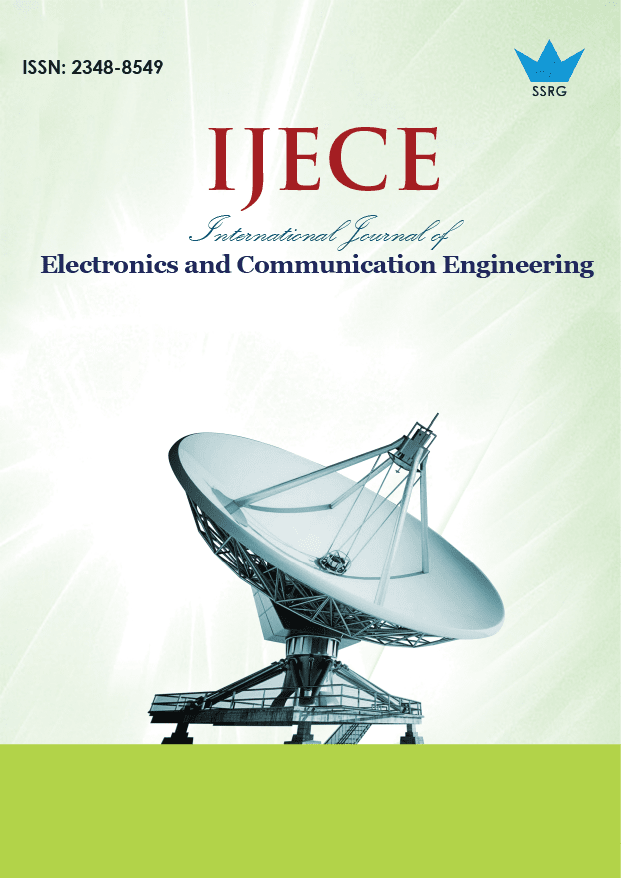Optimizing PSNR and Compression Ratios for Efficient Medical Image Storage and Transmission Using a Hybrid Lossy-Lossless Framework

| International Journal of Electronics and Communication Engineering |
| © 2025 by SSRG - IJECE Journal |
| Volume 12 Issue 6 |
| Year of Publication : 2025 |
| Authors : Bhawesh Joshi, Gurveen Vaseer |
How to Cite?
Bhawesh Joshi, Gurveen Vaseer, "Optimizing PSNR and Compression Ratios for Efficient Medical Image Storage and Transmission Using a Hybrid Lossy-Lossless Framework," SSRG International Journal of Electronics and Communication Engineering, vol. 12, no. 6, pp. 1-14, 2025. Crossref, https://doi.org/10.14445/23488549/IJECE-V12I6P101
Abstract:
As medical imaging data keeps mounting exponentially, there is a growing need for powerful compression methods that can shrink storage requirements and lighten data transfer burdens without sacrificing diagnostic image quality. Through a combination of Convolutional Neural Networks and Support Vector Machines, this new hybrid lossy-lossless compression mechanism delivers a higher Peak Signal-to-Noise Ratio (PSNR) while achieving superior compression efficiency. The new framework merges sophisticated lossy approaches, including Discrete Wavelet Transform (DWT) and quantization methods, with a dependable lossless compression stage through entropy coding techniques. The combined use of CNNs for preprocessing with SVM-based adaptive region classification lets the system selectively encode and compress the image data so important diagnostic regions maintain the highest quality through an increased compression rate applied to less important areas.
Keywords:
Hybrid image compression, Medical image storage, Peak Signal-to-Noise Ratio (PSNR), Convolutional Neural Networks (CNNs), Lossy-lossless compression.
References:
[1] Jingwei Wang et al., “Medical Image Super-Resolution via Diagnosis-Guided Attention,” 2023 IEEE International Conference on Multimedia and Expo (ICME), Brisbane, Australia, pp. 462-467, 2023.
[CrossRef] [Google Scholar] [Publisher Link]
[2] Qi Chen et al., “Muiqa: Image Quality Assessment Database and Algorithm For Medical Ultrasound Images,” 2021 IEEE International Conference on Image Processing (ICIP), Anchorage, AK, USA, pp. 2958-2962, 2021.
[CrossRef] [Google Scholar] [Publisher Link]
[3] Yutian Zhong et al., “Unsupervised Fusion of Misaligned PAT and MRI Images via Mutually Reinforcing Cross-Modality Image Generation and Registration,” IEEE Transactions on Medical Imaging, vol. 43, no. 5, pp. 1702-1714, 2024.
[CrossRef] [Google Scholar] [Publisher Link]
[4] Heba Abedellatif et al., “Non-Exhaustive Search Method for Fractal Image Compression,” 2021 International Conference on Electronic Engineering (ICEEM), Menouf, Egypt, pp. 1-15, 2021.
[CrossRef] [Google Scholar] [Publisher Link]
[5] Pallavi Phadatare, and Pratibha Chavan, “Implementation of DCT and Fractal Compression Technique,” 2021 5th International Conference on Electronics, Communication and Aerospace Technology (ICECA), Coimbatore, India, pp. 83-87, 2021.
[CrossRef] [Google Scholar] [Publisher Link]
[6] Xin Zhang, and Jafar Saniie, “Data Compression for Ultrasonic Microstructure Scattering Signals Using Unsupervised Neural Networks,” 2023 IEEE International Ultrasonics Symposium (IUS), Montreal, QC, Canada, pp. 1-3, 2023.
[CrossRef] [Google Scholar] [Publisher Link]
[7] Sihuan Li et al., “Optimizing Lossy Compression with Adjacent Snapshots for N-body Simulation Data,” 2018 IEEE International Conference on Big Data (Big Data), Seattle, WA, USA, pp. 428-437, 2018.
[CrossRef] [Google Scholar] [Publisher Link]
[8] Lin Zheng, Jingning Han, and Yaowu Xu, “A Saliency Map Approach to Optimize VMAF for Video and Image Compression,” 2024 Data Compression Conference (DCC), Snowbird, UT, USA, pp. 293-301, 2024.
[CrossRef] [Google Scholar] [Publisher Link]
[9] Haiqiao Wang, Dong Ni, and Yi Wang, “Recursive Deformable Pyramid Network for Unsupervised Medical Image Registration,” IEEE Transactions on Medical Imaging, vol. 43, no. 6, pp. 2229-2240, 2024.
[CrossRef] [Google Scholar] [Publisher Link]
[10] Showrov Islam et al., “Generative Adversarial Networks (GANs) in Medical Imaging: Advancements, Applications, and Challenges,” IEEE Access, vol. 12, pp. 35728-35753, 2024.
[CrossRef] [Google Scholar] [Publisher Link]
[11] Zachary M.C. Baum, Yipeng Hu, and Dean C. Barratt, “Meta-Learning Initializations for Interactive Medical Image Registration,” IEEE Transactions on Medical Imaging, vol. 42, no. 3, pp. 823-833, 2023.
[CrossRef] [Google Scholar] [Publisher Link]
[12] Felix Ritter et al., “Medical Image Analysis,” IEEE Pulse, vol. 2, no. 6, pp. 60-70, 2011.
[CrossRef] [Google Scholar] [Publisher Link]
[13] Wang Yang, and Jin-Ren Liu, “Research and Development of Medical Image Fusion,” 2013 IEEE International Conference on Medical Imaging Physics and Engineering, Shenyang, China, pp. 307-309, 2013.
[CrossRef] [Google Scholar] [Publisher Link]
[14] Zhongpai Gao et al., “Dual-View Medical Image Visualization Based on Spatial-Temporal Psychovisual Modulation,” 2014 IEEE International Conference on Image Processing (ICIP), Paris, France, pp. 2168-2170, 2014.
[CrossRef] [Google Scholar] [Publisher Link]
[15] Peng Dong, “The Construction of Medical Imaging Network Teaching System with the PACS in University,” 2012 International Conference on Systems and Informatics (ICSAI2012), Yantai, China, pp. 1023-1025, 2012.
[CrossRef] [Google Scholar] [Publisher Link]
[16] Xi-Zhen Wang et al., “Using the Imaging Network Teaching System Based on PACS in Improvement of Teaching Effect in Medical Imaging,” 2012 International Conference on Systems and Informatics (ICSAI2012), Yantai, China, pp. 1043-1045, 2012.
[CrossRef] [Google Scholar] [Publisher Link]
[17] Yunxiang Li et al., “Zero-Shot Medical Image Translation via Frequency-Guided Diffusion Models,” IEEE Transactions on Medical Imaging, vol. 43, no. 3, pp. 980-993, 2024.
[CrossRef] [Google Scholar] [Publisher Link]
[18] Andreas S. Panayides et al., “AI in Medical Imaging Informatics: Current Challenges and Future Directions,” IEEE Journal of Biomedical and Health Informatics, vol. 24, no. 7, pp. 1837-1857, 2020.
[CrossRef] [Google Scholar] [Publisher Link]
[19] Qingshan Hou et al., “A Collaborative Self-Supervised Domain Adaptation for Low-Quality Medical Image Enhancement,” IEEE Transactions on Medical Imaging, vol. 43, no. 7, pp. 2479-2494, 2024.
[CrossRef] [Google Scholar] [Publisher Link]
[20] Tianyu Shen et al., “Parallel Medical Imaging: An ACP-Based Approach for Intelligent Medical Image Recognition with Small Samples,” 2021 IEEE 1st International Conference on Digital Twins and Parallel Intelligence (DTPI), Beijing, China, pp. 226-229, 2021.
[CrossRef] [Google Scholar] [Publisher Link]
[21] Jinting Wang et al., “GREnet: Gradually Recurrent Network With Curriculum Learning for 2-D Medical Image Segmentation,” IEEE Transactions on Neural Networks and Learning Systems, vol. 35, no. 7, pp. 10018-10032, 2024.
[CrossRef] [Google Scholar] [Publisher Link]
[22] Yating Ling et al., “MTANet: Multi-Task Attention Network for Automatic Medical Image Segmentation and Classification,” IEEE Transactions on Medical Imaging, vol. 43, no. 2, pp. 674-685, 2024.
[CrossRef] [Google Scholar] [Publisher Link]

 10.14445/23488549/IJECE-V12I6P101
10.14445/23488549/IJECE-V12I6P101